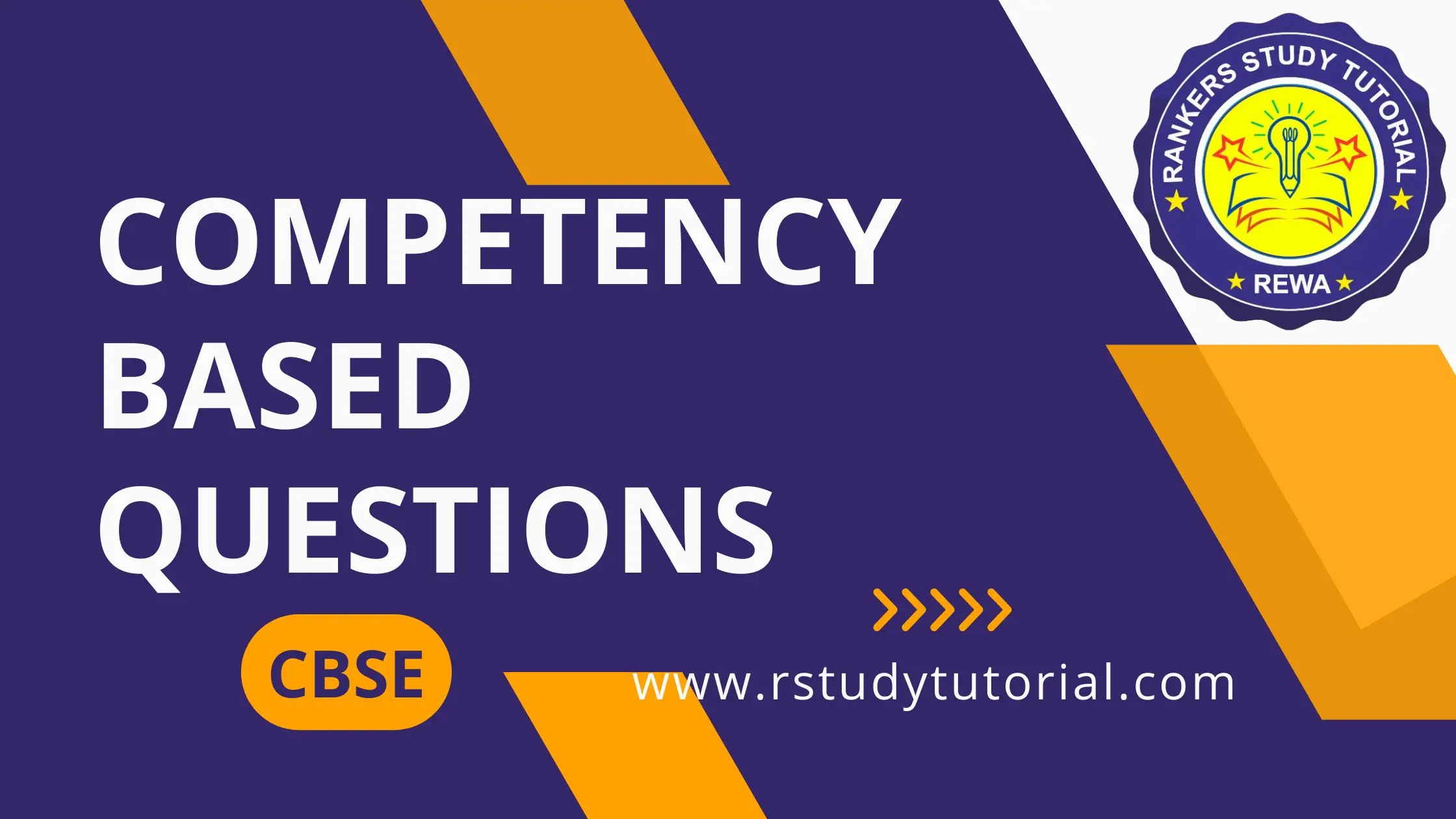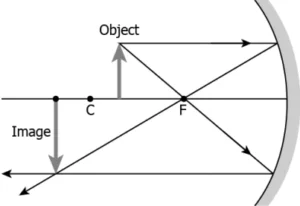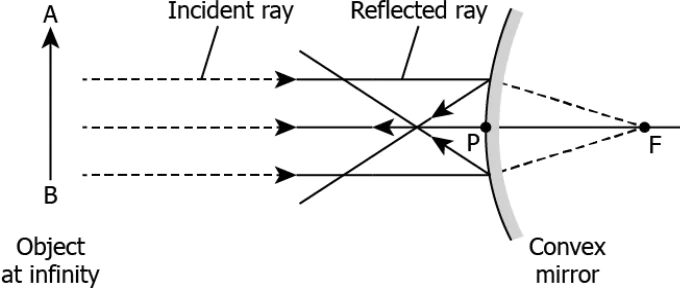Hint: State the laws of reflection of light, in order to understand how light travels in a medium when it encounters another object.
Question.1. Which statement is true for the reflection of light?
(a) The angle of incidence and reflection are equal.
(b) The reflected light is less bright than the incident light.
(c) The sum of angle of incidence and reflection is always greater than 90°.
(d) The beams of incident light after reflection diverges at unequal angles.
Question.2. The image shows reflection of light on a mirror. 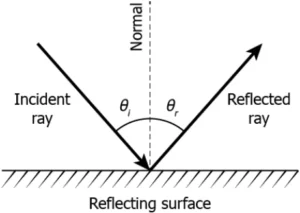
(a) The incident ray, reflected ray, and normal at the point of reflection lie on a common plane.
(b) The angle of incidence, angle of reflection, and normal at the point of reflection lie on a common plane.
(c) The angle between incident ray and normal is greater than the angle between normal and the reflected ray.
(d) The angle between incident ray and normal is smaller than the angle between normal and the reflected ray.
Ans.1. (a) The angle of incidence and reflection are equal.
Ans.2. (b) The angle of incidence, angle of reflection, and normal at the point of reflection lie on a common plane.
Hint: Outline the rule of image formation by spherical mirrors in order to complete the ray diagrams by drawing reflected rays.
Question.3. The image shows the path of incident rays to a concave mirror.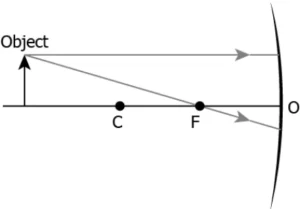
(a) behind the mirror
(b) between F and O
(c) between C and F
(d) beyond C
Question.4. An object is placed near a concave mirror at a distance of one-fourth the radius of curvature of the concave mirror. Which ray diagram shows the incident rays, reflected rays, and the position and nature of the image formed?
(a) 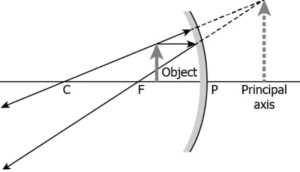
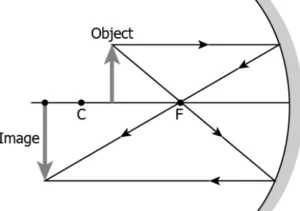
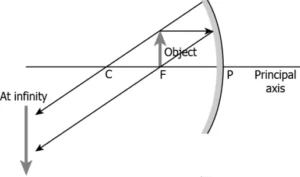
Ans.3. (c) between C and F
Ans.4. (c)
Hint: Represent the path of incident ray and reflected ray in order to decipher the position and nature of image formed.
Question.5. Which image represents the path of incident and reflected ray from a convex mirror when an object is placed at infinity?
(a) 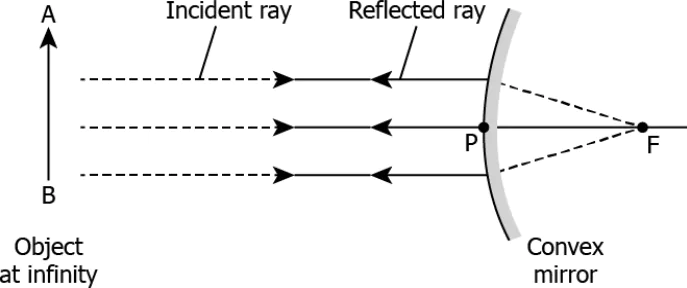
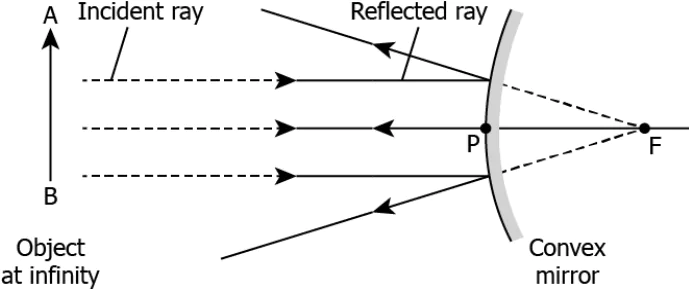
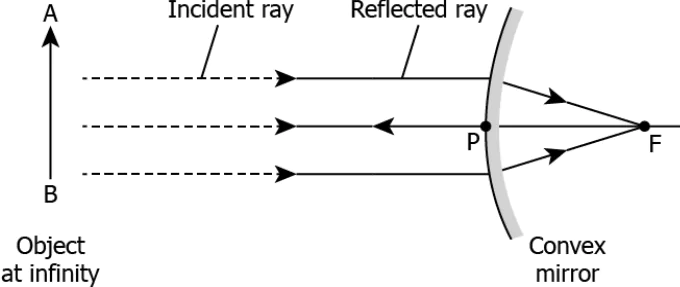
Question.6. A student studies that convex lens always forms virtual image irrespective of its position. What causes the convex mirror to always form a virtual image?
(a) because the reflected ray never intersects
(b) because the reflected ray converges at a single point
(c) because the incident ray traces its path back along the principal axis
(d) because the incident ray of a convex mirror gets absorbed in the mirror
Ans.5. (b) 
Hint: Express u, v, f in the mirror formula in order to apply sign convention in solving word problems to find the unknown variable.
Question.7. A student conducts an activity using a concave mirror with focal length of 10 cm. He placed the object 15 cm from the mirror. Where is the image likely to form?
(a) at 6 cm behind the mirror
(b) at 30 cm behind the mirror
(c) at 6 cm in front of the mirror
(d) at 30 cm in front of the mirror
Question.8. Rekha placed a juice bottle at a distance of 20 cm in front of a convex mirror which has a focal length of 20 cm. Where is the image likely to form?
(a) at focus behind the mirror
(b) at focus in front of the mirror
(c) at a distance of 10 cm behind the mirror
(d) at a distance of 10 cm in front of the mirror
Ans.7. (d) at 30 cm in front of the mirror
Ans.8. (c) at a distance of 10 cm behind the mirror
Hint: Deduce the nature and size of image by magnification in order to relate height of object with height of image.
Question.9. A student conducts an activity using a flask of height 15 cm and a concave mirror. He finds that the image formed is 45 cm in height. What is the magnification of the image?
(a) -3 times
(b) -1/3 times
(c) 1/3 times
(d) 3 times
Question.10. Sunil conducts an activity using an object of height 10 cm and a convex mirror of focal length 20 cm. He placed the object at a distance of 20 cm in front of the mirror. What is likely to be height of the image produced?
(a) 1 cm
(b) 5 cm
(c) 10 cm
(d) 20 cm
Ans.9. (d) 3 times
Ans.10. (b) 5 cm
Hint: Demonstrate the path of light when it travels through a rectangular glass slab, in order to formulate laws of refraction of light.
Question.11. The image shows the path of light travelling through a glass slab.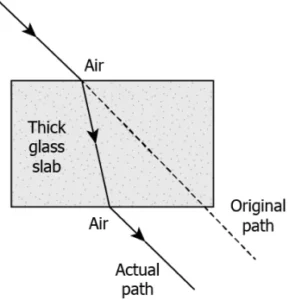
(a) change in the amount of light
(b) change in the direction of wind flow
(c) change in the temperature of the air
(d) change in the density of the medium
Question.12. A student studies that when a ray of light travels from air into the glass slab, the ray of light bends towards the normal. But as refracted ray emerges out of the glass slab to the vacuum, it bends away from the normal, as shown.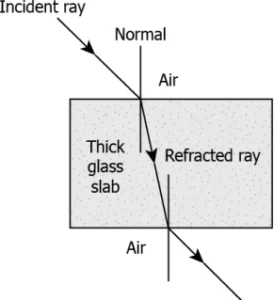
(a) light always bends towards the normal in a glass slab
(b) ray of light always travels in a straight path irrespective of change in medium
(c) the incident ray, the refracted ray, and the normal to the interface always lie on the same plane
(d) ray of light travelling in the air is always considered as the incident ray, and the one in the glass is the refracted ray
Ans.11. (d) change in the density of the medium
Ans.12. (c) the incident ray, the refracted ray, and the normal to the interface always lie on the same plane
Hint: Compare speed of light in one medium with another in order to calculate refractive index.
Question.13. A student studies that speed of light in air is 300000 kms/sec where that of speed in a glass slab is about 197000 kms/sec. What causes the difference in speed of light in these two media?
(a) difference in density
(b) difference in temperature
(c) difference in amount of light
(d) difference in direction of wind flow
Question.14. The speed of light in air is 3 \times 10^{8} ms^{-1} , whereas that of the speed of light in water is 2.26 \times 10^{8} ms^{-1} . What is the refractive index of water with respect to air?
(a) 1
(b) 0.75
(c) 1.32
(d) 2.64
Ans.13. (a) difference in density
Ans.14. (c) 1.32
Hint: Represent the path of incident & reflected light rays from a concave lens, in order decipher the position and nature of image formed.
Question.15. The image represents the rays of light travelling through a concave lens.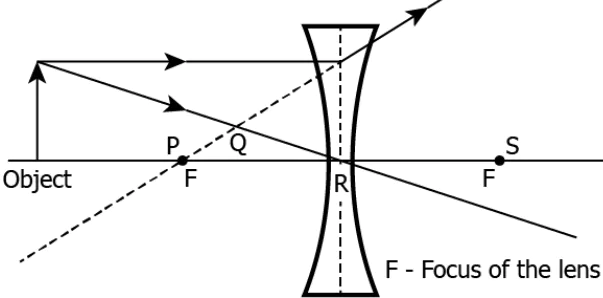
(a) P
(b) Q
(c) R
(d) S
Question.16. Rahul conducts an experiment using an object of height 10 cm and a concave lens with focal length 20 cm. The object is placed at a distance of 25 cm from the lens. Can the image be formed on a screen?
(a) yes, as the image formed will be real
(b) yes, as the image formed will be erect
(c) no, as the image formed will be virtual
(d) no, as the image formed will be inverted
Ans.15. (b) Q
Ans.16. (c) no, as the image formed will be virtual
Hint: Illustrate the path of incident & reflected light rays from a convex lens, in order decipher the position and nature of image formed.
Question.17. The image represents the rays of light travelling through a convex lens.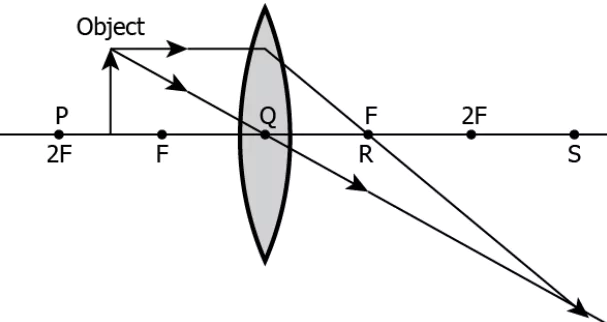
(a) position P
(b) position Q
(c) position R
(d) position S
Question.18. A student conducts an experiment using a convex lens of focal length 20 cm and an object of height 15 cm. He placed the object at 25 cm from the lens. Can the image be formed on a screen?
(a) yes, because a real image will be formed
(b) no, because a virtual image will be formed
(c) yes, because an erect image will be formed
(d) no, because an inverted image will be formed
Ans.17. (d) position S
Ans.18. (a) yes, because a real image will be formed
Hint: Construct the lens formula for a lens relating v, u, f; in order to find an unknown variable given the other two.
Question.19. Kumar conducts an experiment using a concave lens with focal length of 20 cm. He places an object at a distance of 30 cm in front of the lens. Where is the image most likely to form?
(a) 10 cm in front of the lens
(b) 12 cm in front of the lens
(c) 30 cm in front of the lens
(d) 60 cm in front of the lens
Question.20. Rakhi conducts an experiment to produce an image of an object on a screen which is placed at 20 cm from the lens. She uses a convex lens of focal length 15 cm for the experiment.
Where should she place the object in order to produce the sharpest image?
(a) 8 cm in front of the lens
(b) 15 cm in front of the lens
(c) 20 cm in front of the lens
(d) 60 cm in front of the lens
Ans.19. (b) 12 cm in front of the lens
Ans.20. (d) 60 cm in front of the lens
Hint: State the magnification for a lens, in order to relate height of object with height of image.
Question.21. An image of an object produced on a screen which is about 36 cm using a convex lens. The image produced is about 3 times the size of the object. What is the size of the object?
(a) 12 cm
(b) 33 cm
(c) 39 cm
(d) 108 cm
Question.22. An object of height 10 cm is placed in front of a convex lens having focal length of 12 cm. The object is placed at a distance of 36 cm in front of the lens. How many times is the image likely to be magnified?
(a) ½ times
(b) 2 times
(c) 3 times
(d) 4 times
Ans.21. (a) 12 cm
Ans.22. (a) ½ times
Hint: Calculate the power of a lens, in order to determine its power to converge or diverge.
Question.23. A concave lens has a focal length of 20 cm. What is the power of the lens?
(a) -5 dioptre
(b) -0.05 dioptre
(c) 0.05 dioptre
(d) 5 dioptre
Question.24. A student conducts an experiment using a convex lens. He places the object at a distance of 60 cm in front of the lens and observed that the image is formed at a distance of 30 cm behind the lens. What is the power of the lens?
(a) 0.005 dioptre
(b) 0.05 dioptre
(c) 5 dioptre
(d) 50 diptre
Ans.23. (a) -5 dioptre
Ans.24. (c) 5 dioptre

